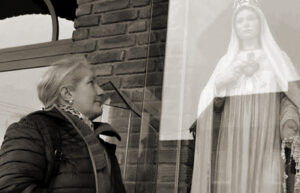The Antichrist in Scripture
Sacred Tradition affirms that, near the end of time, a certain man whom St. Paul calls “the lawless one” is expected to rise as a false Christ in the world, setting himself as an object of worship. His timing was revealed to Paul as before the “day of the Lord”:
Let no one deceive you in any way; for that day will not come, unless the apostasy comes first, and the man of lawlessness is revealed, the son of perdition. (2 Thess 2:3)
Some Church Fathers saw in the prophet Daniel's vision a foretelling of this blasphemous figure who emerges from the kingdom of a "beast":
I was considering the ten horns it had, when suddenly another, a little horn, sprang out of their midst, and three of the previous horns were torn away to make room for it. This horn had eyes like human eyes, and a mouth that spoke arrogantly. (Daniel 7:8)
This finds its echo in St. John's Apocalypse:
The beast was given a mouth uttering proud boasts and blasphemies, and it was given authority to act for forty-two months. It opened its mouth to utter blasphemies against God, blaspheming his name and his dwelling and those who dwell in heaven. It was also allowed to wage war against the holy ones and conquer them, and it was granted authority over every tribe, people, tongue, and nation. (Rev 13:5-7)
Thus, the Early Church Fathers unanimously confirmed that the “son of perdition” is a person and not just a "system" or kingdom. However, Benedict XVI made the important point:
As far as the antichrist is concerned, we have seen that in the New Testament he always assumes the lineaments of contemporary history. He cannot be restricted to any single individual. One and the same he wears many masks in each generation. —Cardinal Ratzinger (POPE BENEDICT XVI), Dogmatic Theology, Eschatology 9, Johann Auer and Joseph Ratzinger, 1988, p. 199-200
That is a viewpoint consonant with Sacred Scripture:
Children, it is the last hour; and just as you heard that the antichrist was coming, so now many antichrists have appeared. Thus we know this is the last hour… Whoever denies the Father and the Son, this is the antichrist. (1 John 2:18, 22)
Still, Benedict affirmed the constant teaching of the Church that the Antichrist is also a future individual, part of this beast that will rule the earth for "forty-two months."[1]Rev 13:5 That is simply to say that there are many antichrists throughout human history. Yet, Scripture points especially to one, chief among many, who accompanies a great rebellion or apostasy toward the end of time. The Church Fathers refer to him as the “son of perdition”, the “lawless one”, a “king”, an “apostate and robber” whose origin is likely from the Middle East, possibly of Jewish heritage.
…before the Lord’s arrival there will be apostasy, and one well described as the “man of lawlessness”, “the son of perdition” must be revealed, who tradition would come to call the Antichrist. —General Audience, “Whether at the end of time or during a tragic lack of peace: Come Lord Jesus!”, L’Osservatore Romano, Nov. 12th, 2008
But when will he arrive?
…if we study but a moment the signs of the present time, the menacing symptoms of our political situation and revolutions, as well as the progress of civilization and the increasing advance of evil, corresponding to the progress of civiliation and the discoveries in the material order, we cannot fail to foresee the proximity of the coming of the man of sin, and of the days of desolation foretold by Christ. —Fr. Charles Arminjon (1824-1885), The End of the Present World and the Mysteries of the Future Life, p. 58; Sophia Institute Press
The Chronology of the Deceiver
There are essentially two camps on this, but as I will point out, they are not necessarily in opposition to one another.
The first camp, and the most prevalent one today, is that the Antichrist appears at the very end of time, immediately before the final return of Jesus in glory, the judgment of the dead, and end of the world.[2]Rev 20:11-21:1
The other camp is the one that most prevalent among the Early Church Fathers and which, notably, simply follows the chronology of St. John the Apostle in Revelation. And that is that the coming of the lawless one is followed by a “thousand years”, what the Church Fathers called a “sabbath rest”, the “seventh day”, “the times of the kingdom” or “the Day of the Lord.” This "period of peace," as Our Lady of Fatima called it, is not the heresy of Millenarianism (see Millenarianism—What it is, and What it isn't) whose adherents believed that Jesus would come to reign in the flesh for a literal thousand years. What the Church has never condemned, however, is the idea of a spiritual triumph of the Church after a time of tribulation. Summarizing the collective thought of the Magisterium, Fr. Charles Arminjon wrote:
The most authoritative view, and the one that appears to be most in harmony with Holy Scripture, is that, after the fall of the Antichrist, the Catholic Church will once again enter upon a period of prosperity and triumph. —The End of the Present World and the Mysteries of the Future Life, Fr. Charles Arminjon (1824-1885), p. 56-57; Sophia Institute Press
This is simply consistent with the straightforward reading of Revelation. Clearly, Chapter 19 speaks of a manifestation of Jesus' power, in fact, His "breath" or "brightness" to slay the "beast" and "false prophet" who are then cast into the lake of fire. But it's not the end of the world. What follows is a reign of Christ with his saints.
St. Thomas and St. John Chrysostom explain the words quem Dominus Jesus destruet illustratione adventus sui (“whom the Lord Jesus will destroy with the brightness of His coming”) in the sense that Christ will strike the Antichrist by dazzling him with a brightness that will be like an omen and sign of His Second Coming… —Fr. Charles Arminjon, Ibid., p. 56-57
What follows, according to the Early Church Fathers, is a time of peace and justice, the times of the kingdom when Christ reigns, not in the flesh, but in His saints in an all new manner. In modern Catholic mysticism, this is referred to as the "Kingdom of the Divine Will", the "Eucharistic Reign", the "Era of Peace", the "Era of Celestial Love"etc.
But when The Antichrist shall have devastated all things in this world, he will reign for three years and six months, and sit in the temple at Jerusalem; and then the Lord will come from Heaven in the clouds… sending this man and those who follow him into the lake of fire; but bringing in for the righteous the times of the kingdom, that is, the rest, the hallowed seventh day… These are to take place in the times of the kingdom, that is, upon the seventh day… the true Sabbath of the righteous. —St. Irenaeus of Lyons, Church Father (140–202 A.D.); Adversus Haereses, Irenaeus of Lyons, V.33.3.4, The Fathers of the Church, CIMA Publishing Co.
Thus, the "seventh day" is a rest for the Church as God rested on the seventh day of creation. What follows is the "eighth" day, that is, eternity.
…when His Son will come and destroy the time of the lawless one and judge the godless, and change the sun and the moon and the stars—then He shall indeed rest on the seventh day… after giving rest to all things, I will make the beginning of the eighth day, that is, the beginning of another world. —Letter of Barnabas (70-79 A.D.), written by a second century Apostolic Father
We shall indeed be able to interpret the words, “The priest of God and of Christ shall reign with Him a thousand years; and when the thousand years shall be finished, Satan shall be loosed out of his prison;” for thus they signify that the reign of the saints and the bondage of the devil shall cease simultaneously… —St. Augustine, The Anti-Nicene Fathers, City of God, Book XX, Chap. 13, 19
The Popes and the Antichrist Today
It is noteworthy that Pope St. Pius X already thought the Antichrist was on earth:
Who can fail to see that society is at the present time, more than in any past age, suffering from a terrible and deep-rooted malady which, developing every day and eating into its inmost being, is dragging it to destruction? You understand, Venerable Brethren, what this disease is—apostasy from God… When all this is considered there is good reason to fear lest this great perversity may be as it were a foretaste, and perhaps the beginning of those evils which are reserved for the last days; and that there may be already in the world the “Son of Perdition” of whom the Apostle speaks. —E Supremi, Encyclical On the Restoration of All Things in Christ, n. 3, 5; October 4th, 1903
Noting the outbreak of contempt toward Christianity throughout the world, his successor concurred:
…the whole Christian people, sadly disheartened and disrupted, are continually in danger of falling away from the faith, or of suffering the most cruel death. These things in truth are so sad that you might say that such events foreshadow and portend the “beginning of sorrows,” that is to say of those that shall be brought by the man of sin, “who is lifted up above all that is called God or is worshipped” (2 Thess 2:4). —POPE PIUS XI, Miserentissimus Redemptor, Encyclical Letter on Reparation to the Sacred Heart, n. 15, May 8th, 1928
While still a Cardinal, Benedict XVI made an astonishing allusion to the "mark of the beast" as it relates to computer technology:
The Apocalypse speaks about God’s antagonist, the beast. This animal does not have a name, but a number. In [the horror of the concentration camps], they cancel faces and history, transforming man into a number, reducing him to a cog in an enormous machine. Man is no more than a function. In our days, we should not forget that they prefigured the destiny of a world that runs the risk of adopting the same structure of the concentration camps, if the universal law of the machine is accepted. The machines that have been constructed impose the same law. According to this logic, man must be interpreted by a computer and this is only possible if translated into numbers. The beast is a number and transforms into numbers. God, however, has a name and calls by name. He is a person and looks for the person. —Cardinal Ratzinger, (POPE BENEDICT XVI) Palermo, March 15th, 2000
Then in 1976, two years before being elected Pope John Paul II, Cardinal Wojtyla addressed the bishops of America. These were his words, recorded in the Washington Post, and confirmed by Deacon Keith Fournier who was in attendance:
We are now standing in the face of the greatest historical confrontation humanity has ever experienced. We are now facing the final confrontation between the Church and the anti-church, between the Gospel and the anti-gospel, between Christ and the antichrist. —Eucharistic Congress for the bicentennial celebration of the signing of the Declaration of Independence, Philadelphia, PA, 1976; cf. Catholic Online
In closing, we want to remind the reader that this website is to prepare you, not for the Antichrist, but for the coming of Jesus Christ to put an end to the tears of the past millennium. It is to prepare you for the coming of the Kingdom of the Divine Will. As such, the wisdom of the saints provide much for reflection:
Blessed shall they be who overcome the tyrant then. For they shall be set forth as more illustrious and loftier than the first witnesses; for the former witnesses overcame his minions only, but these overthrow and conquer the accuser himself, the son of perdition. With what eulogies and crowns, therefore, will they not be adorned by our King, Jesus Christ!… You see in what manner of fasting and prayer the saints will exercise themselves at that time. —St. Hippolytus, On the End of the World, n. 30, 33, newadvent.org
The Church now charges you before the Living God; she declares to you the things concerning Antichrist before they arrive. Whether they will happen in your time we know not, or whether they will happen after you we know not; but it is well that, knowing these things, you should make yourself secure beforehand. —St. Cyril of Jerusalem (c. 315-386) Doctor of the Church, Catechetical Lectures, Lecture XV, n.9
For an extensive treatment of the "end times" according to the Church Fathers, the Magisterium, and approved prophetic revelations, read Rethinking the End Times, How the Era was Lost, and The Day of Justice by Mark Mallett. Also see Antichrist in Our Times , Dear Holy Father... He is Coming! and Why Aren't the Popes Shouting?

 Alicja Lenczewska
Alicja Lenczewska



 Elizabeth Kindelmann
Elizabeth Kindelmann Through what became The Spiritual Diary, Jesus and Mary taught Elizabeth, and they continue to instruct the faithful in the divine art of suffering for the salvation of souls. Tasks are assigned for each day of the week, which involve prayer, fasting, and night vigils, with beautiful promises attached to them, laced with special graces for priests and the souls in purgatory. In their messages, Jesus and Mary say that The Flame of Love of the Immaculate Heart of Mary is the greatest grace given to mankind since the Incarnation. And in the not-so-distant future, her flame will engulf the entire world.
Through what became The Spiritual Diary, Jesus and Mary taught Elizabeth, and they continue to instruct the faithful in the divine art of suffering for the salvation of souls. Tasks are assigned for each day of the week, which involve prayer, fasting, and night vigils, with beautiful promises attached to them, laced with special graces for priests and the souls in purgatory. In their messages, Jesus and Mary say that The Flame of Love of the Immaculate Heart of Mary is the greatest grace given to mankind since the Incarnation. And in the not-so-distant future, her flame will engulf the entire world. Father Stefano Gobbi
Father Stefano Gobbi Why Gisella Cardia?
Why Gisella Cardia? Thirdly, the messages have frequently been accompanied by visible phenomena, photographic evidence found in In Cammino con Maria, which cannot be the fruit of subjective imagination, notably the presence of the stigmata on Giselle’s body and and the appearance of crosses or religious texts in blood on Gisella’s arms. See the pictures taken from her apparition website
Thirdly, the messages have frequently been accompanied by visible phenomena, photographic evidence found in In Cammino con Maria, which cannot be the fruit of subjective imagination, notably the presence of the stigmata on Giselle’s body and and the appearance of crosses or religious texts in blood on Gisella’s arms. See the pictures taken from her apparition website 
 Jennifer
Jennifer
 Why Manuela Strack?
Why Manuela Strack?

 Why the Visionaries of Our Lady of Medjugorje?
Why the Visionaries of Our Lady of Medjugorje? Why Pedro Regis?
Why Pedro Regis? Why the Servant of God Luisa Piccarreta?
Why the Servant of God Luisa Piccarreta? of the saints. It wasn’t until she became a “Daughter of Mary” that the nightmares finally ceased at the age of eleven. In the following year, Jesus began to speak interiorly to her especially after receiving Holy Communion. When she was thirteen, He appeared to her in a vision that she witnessed from the balcony of her home. There, in the street below, she saw a crowd and armed soldiers leading three prisoners; she recognized Jesus as one of them. When He arrived beneath her balcony, He raised his head and cried out: “Soul, help Me!” Deeply moved, Luisa offered herself from that day on as a victim soul in expiation for the sins of mankind.
of the saints. It wasn’t until she became a “Daughter of Mary” that the nightmares finally ceased at the age of eleven. In the following year, Jesus began to speak interiorly to her especially after receiving Holy Communion. When she was thirteen, He appeared to her in a vision that she witnessed from the balcony of her home. There, in the street below, she saw a crowd and armed soldiers leading three prisoners; she recognized Jesus as one of them. When He arrived beneath her balcony, He raised his head and cried out: “Soul, help Me!” Deeply moved, Luisa offered herself from that day on as a victim soul in expiation for the sins of mankind. immobile, rigid-like state that appeared almost as if she were dead. It was only when a priest made the sign of the Cross over her body that Luisa regained her faculties. This remarkable mystical state persisted until her death in 1947—followed by a funeral that was no little affair. During that period in her life, she suffered no physical illness (until she succumbed to pneumonia at the end) and she never experienced bedsores, despite being confined to her little bed for sixty-four years.
immobile, rigid-like state that appeared almost as if she were dead. It was only when a priest made the sign of the Cross over her body that Luisa regained her faculties. This remarkable mystical state persisted until her death in 1947—followed by a funeral that was no little affair. During that period in her life, she suffered no physical illness (until she succumbed to pneumonia at the end) and she never experienced bedsores, despite being confined to her little bed for sixty-four years. Why Simona and Angela?
Why Simona and Angela?
 Valeria Copponi
Valeria Copponi